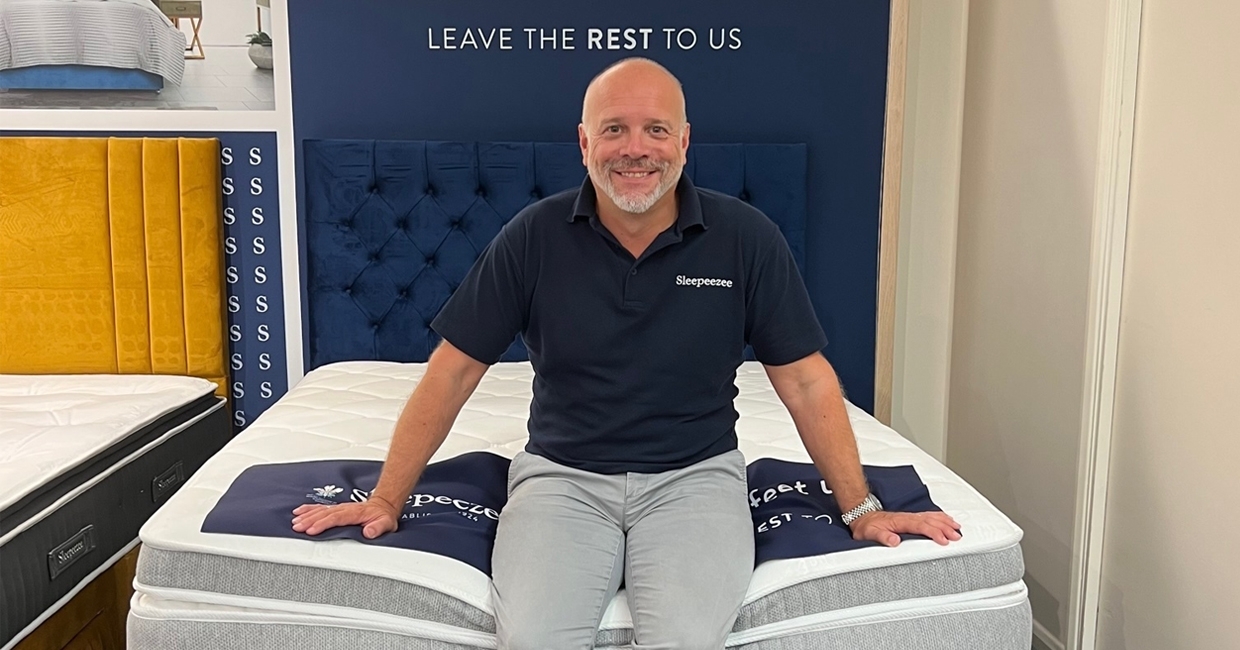Sleepeezee’s Steve Warren is taking the historic bed brand to new heights, and the results speak for themselves – but what’s the secret of his success? Paul Farley checked in with the bedmaker’s principals in Strood, Kent, to find out …
Sleepeezee? Given the brand’s trajectory, its staff deserve to. But since France’s Adova Group took over in 2018, there’s been no resting on that growing pile of laurels.
For MD Steve Warren – a COO in a former life – there’s never a dull day at HQ. Having taken on the mantle in March 2021, he’s only known challenge and change, mid-pandemic upheaval only briefly giving way to some normality before the next crisis – be it material prices, Ukraine, cost of living – reared its head.
But Steve is well equipped to handle it. Calm, cool, and confidently focused on the company’s long-term goals, he’s oiled this near-100-year-old machine and pulled it into crystal-clear focus, with impressive results. Sleepeezee achieved a gross turnover of £27m in 2018, £33m in 2019, and £30m in 2020. It then accelerated through the pandemic, achieving £36.7m in 2021, and is now on track to hit £41.5m in 2022. That’s an uptick of +50% in just four years – and a strong position from which to hit the company’s target of £50m by 2025.
Stitch in time
I last visited the bedmaker’s factory in 2019, and heard how (then) CEO Joe Wykes planned to cement Sleepeezee’s status in the pantheon of household name bed brands. From a well-researched foundation, Sleepeezee embarked on a multichannel branding journey spearheaded by Amy Curtis (now head of marketing) – and while some of its competitors pulled up the drawbridges when Covid-19 came knocking, Sleepeezee maintained its momentum.
“It wasn’t an easy decision to make, but if we’re going to leverage the brand and realise what Sleepeezee can really be, we’re going to have to make more of our identity, not less,” Amy explains. “You can’t put your head in the sand in this market, even for just a few months. Cutting that spend would’ve sucked the wind right out of our sails.”
Amy believes that a good deal of opportunity remains in this space. “People always need brands,” she says. “Some do OK without them, but only for so long. In tough times like these, brands give customers reassurance around what they’re purchasing – which is especially important for big-ticket items.”
She admits that the brand is some way off being a well-recognised D2C proposition, but has seen impressive returns from assigning spend to the most cost-effective channels – digital, radio, and a 2500-ad campaign across the London Underground this spring, for example – as well as overhauling its showroom. “We’re trying to be clever with our money,” she says.
The entire exercise is underpinned by integrity and establishing credibility. Steve is the first to admit that, given the challenges the company’s faced, ‘doing the right thing’ has often proved costly – but, he states, any business that invests so heavily in brand building needs to make sure its moral foundations are sound, or the cracks will quickly show.
“The pandemic squeezed our supply chain, like everyone else. But if we couldn’t provide what we were supposed to, we always made sure our substitute materials were an upgrade – we’d overcompensate. There were lots of concessions, but every time, we made sure the customer knew what we were doing.
“For where we’re trying to take the brand, we need to be careful. We need to stand for the right things. Yes, we need to be profitable – but not at the expense of our morals. If we can’t do something, we’ll turn around and say so.”
Pillow talk
Sleepeezee’s internal processes have also become more transparent, ensuring better communication between all parties. Each week, its managers attend at least five regular meetings, covering everything from marketing to capacity, and assessing the flow of business comfortably ahead of time.
“It’s definitely a more cohesive and coherent approach,” he explains. “It creates a culture of decision-making, and means we talk about some of the things we weren’t comfortable confronting before, like liquidity – in this unpredictable world, having as much headroom as you can is everything.”

Sleepeezee’s principal factory in Strood, Kent
Rather than leaving capacity planning solely to the factory, Steve put commercial director David Miller in charge of what’s produced and when, figuring that keeping customers satisfied with timely deliveries was as important as optimising manufacturing output.
“When Covid-19 hit, it was a difficult balance to feed all of the differing customer lead times, and it would have been easy to push out some of our smaller customers’ far more, which in our opinion would have been a bit short-sighted. Customers put a lot of stock in relationships – if you mess it up, it takes years to get back,” says Steve.
“Now David’s running capacity planning, we can identify where demand from large and small customers might clash ahead of time, and ensure we deliver on all our promises. If we say we’re going to do something, we have to do it.”
Last year, Sleepeezee ‘rationalised’ its customer base, letting go of some smaller accounts it was struggling to service effectively. It’s since enjoyed healthy growth among AIS members (“a good barometer of where the brand is”, says David) and elsewhere, and now handles some 145 retail accounts.
Of course, Sleepeezee has made gains in the nationals – relaunching the Therapur line with Dreams, and growing its presence in Furniture Village, for example. But it has also gone from 850 to 1100 independent retail floor models in the past year-and-a-half alone, reflecting its growing popularity in the sector.
On the up
Of course, it’s not all rosy. After raising its prices last winter, increasing costs forced Sleepeezee to levy a further hike this summer.
“Some of those big commodity suppliers need to understand that they will end up slowing consumer demand,” says Steve, “but recent events have certainly shown us how fragile the global economy can be. Thankfully, material prices seem to have plateaued at the moment.”
David picks up the thread: “I don’t think anyone was predicting we’d go into recession, or what happened in Ukraine. But you can paralyse yourself by focusing on the negative.
“If people are feeling the doom and gloom, how great is it that we’re pushing the boundaries and moving forward? Whether it’s tough for the next six months or a year, it’s time to position ourselves so when the tide turns we can take advantage of it. Retailers want to see innovation. They want that point of difference. They want to know if we’ve identified a gap in the market – and we’re ready to deliver on all fronts.”

Recent investment has helped transform Sleepeezee’s on-site showroom
Having enjoyed its most successful Bed Show yet in 2021, Sleepeezee will be back in Telford this month with a host of new and upgraded products, including a refreshed Cooler collection and a relaunched Backcare line. Half of the stand will be dedicated to bricks-and-mortar exclusives, including three new ranges.
“Etail has taken a big step back, for now – but buyers are always evolving, so we need to be flexible in our approach,” says David.
Holding the line
The day of my visit is a hot one, but it’s at the back end of a heatwave, so the factory staff are making hay while the sun shines a little less fiercely, the heavy-duty cooling fans now stowed away.
The factory employs some 240 workers, says long-serving manufacturing manager Paul Thomas, and has seen numerous improvements under the new owners, from automation – a state-of-the-art quilting machine, for example – to energy-saving mechanisms.
Others are less tangible, but arguably more impactful. Sleepeezee has long maintained staff pay above the minimum wage, and now remunerates its workers in line with the national living wage. The staff facilities have been comprehensively refurbished, and working areas reinvented in line with each team’s wishes.
“The people here are the most important thing,” says Paul (this ethos was celebrated in mini-documentary form in Natwest and ITV’s Backing Business campaign earlier this year). “Pretty much everything is still handmade. Investment in new machinery doesn’t mean staff are made redundant – they’re retrained.”
The factory produces around 2300 mattresses each week (2500 at a push), and Paul is aiming to take that to 2650 by the year’s end – which demands careful and continual assessment, and training to ensure workers are competent in a range of areas.
There are opportunities to further speed up production, but Paul is wary of the possible impact on quality. He offers embroidery, a Sleepeezee specialism, by way of example: “We need to get our stitching just right – especially so when we’re sewing in the Royal Warrant seal. Heat stamping is quicker, but we don’t want to compromise on quality, even though we could get more speed. Our customers expect a certain standard.”
Over the years, attempts have been made to apply lean principles to Sleepeezee’s factory, but the layout resists simplification due to the sheer breadth of the company’s offer. Whereas some bedmakers specialise, Sleepeezee prides itself on covering all the bases, and doing it well – but this leaves little opportunity for volume-driven gains.
“We do so much here,” explains David, “from Travelodge singles to luxury hand side-stitched models for hotels like the Mandarin Oriental.”
Steve continues: “The factory’s just not set up to cater to just one model, and our approach to our audience is the same. Nationals, independents, hotels, boutique hotels, export … it’s important to have a well-balanced portfolio.”
David concurs: “Export and contract have different rhythm to retail,” he says. “While retail demand slowed for us in Q2, those areas were spot-on budget. By focusing on the right sectors – and the right customers within those sectors – you can de-risk the business, which works in everyone’s favour.”
Rest practice
If it realises its target of £50m by 2025, Sleepeezee plans to invest further in the site. The jury is out on exactly how the money would be spent, but Steve’s preference would be the redevelopment of the badly designed WW2 lookalike military barracks north of the main factory, for use as material storage and a dedicated contract division.
For now, however, the work continues, and the brand takes on ever-greater substance.
“If you want to be a brand, just be ready and waiting,” Steve concludes. “When the time comes, make it impossible for them to say no to you. Be confident in your proposition – but humble, and able to turn accounts away if they don’t fit. Work closely with your customers on margin and products, and check back in with them regularly to make sure everything’s working. Expect loyalty, and demonstrate loyalty. Temper your ambition, and make sure you deliver – even if it means taking the more difficult path.”
Read more about Sleepeezee's product pipeline in this year's Bed Buyer supplement.












